

Units of transportation measurement - Wikipedia. The units of transportation measurement describes the unit of measurement used to measure the quantity and traffic of transportation used in transportation statistics, planning, and their related fields.
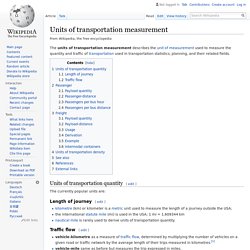
Units of transportation quantity[edit] The currently popular units are: Length of journey[edit] kilometre (km) or kilometer is a metric unit used to measure the length of a journey outside the USA;the international statute mile (mi) is used in the USA; 1 mi = 1.609344 kmnautical mile is rarely used to derive units of transportation quantity. Traffic flow[edit] vehicle-kilometre as a measure of traffic flow, determined by multiplying the number of vehicles on a given road or traffic network by the average length of their trips measured in kilometres.[1]vehicle-mile same as before but measures the trip expressed in miles.
Passenger[edit] Payload quantity[edit] passenger or person (p) Passenger-distance[edit] International Bus Benchmarking Group. Sample E-mail Letters. Guidelines for Review ProcessHow do we keep the review process on time?
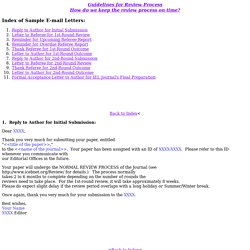
Index of Sample E-mail Letters: Back to Index< 1. Reply to Author for Initial Submission: Dear XXXX, Thank you very much for submitting your paper, entitled "<<title of the paper>>," to the <<name of the journal>>. Your paper will undergo the NORMAL REVIEW PROCESS of the Journal (see for details.) Once again, thank you very much for your submission to the XXXX. Best wishes, Your NameXXXX Editor >Back to Index< 2. How are you? Your prompt action will be greatly appreciated by me as well as the authors who are very anxious to know the outcome of the review process. Top 13 master data management (MDM) buzzwords and definitions. MDM definitions By submitting your email address, you agree to receive emails regarding relevant topic offers from TechTarget and its partners.
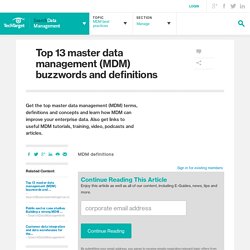
You can withdraw your consent at any time. Contact TechTarget at 275 Grove Street, Newton, MA. You also agree that your personal information may be transferred and processed in the United States, and that you have read and agree to the Terms of Use and the Privacy Policy. Amazon. How do operational data integration and analytical integration differ? What is operational data integration?

How is it different from analytical data integration? Should companies plan for both? When folks discuss analytical data integration, they are typically referring to moving and integrating large volumes of data in a manner that allows a delay between the actual time the data is created and when it is loaded into the target system (the delay can be minutes, hours, days or longer). This is the most common approach to integrating and loading data into a data warehouse.
When people talk about operational data integration, they are typically referring to migrating and loading small... By submitting your email address, you agree to receive emails regarding relevant topic offers from TechTarget and its partners. You also agree that your personal information may be transferred and processed in the United States, and that you have read and agree to the Terms of Use and the Privacy Policy. Critère de succès : la taille de l'équipe. Il y a eu de nombreuses études sur la performance des équipes en fonction de leur taille.

La conclusion générale est que la taille optimale d'une équipe se situe à peu près entre sept et onze personnes. Il s'agit d'un juste équilibre, entre d'une part une équipe avec trop peu de personnes pour assurer la diversité et l'expertise et, d'autre part trop de personnes pour obtenir une pleine participation et une communication ouverte.Lorsque les équipes deviennent trop grandes, il leur est très difficile de parvenir à une compréhension commune d'un problème ou d'une situation.
Database tuning. Database tuning describes a group of activities used to optimize and homogenize the performance of a database.
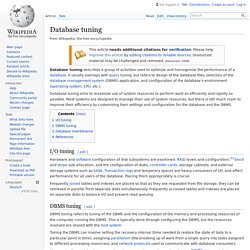
It usually overlaps with query tuning, but refers to design of the database files, selection of the database management system (DBMS) application, and configuration of the database's environment (operating system, CPU, etc.). Database tuning aims to maximize use of system resources to perform work as efficiently and rapidly as possible. Most systems are designed to manage their use of system resources, but there is still much room to improve their efficiency by customizing their settings and configuration for the database and the DBMS. Database. Database management systems (DBMSs) are specially designed software applications that interact with the user, other applications, and the database itself to capture and analyze data.
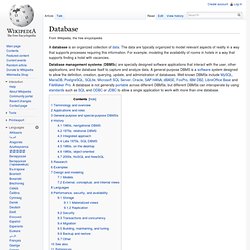
A general-purpose DBMS is a software system designed to allow the definition, creation, querying, update, and administration of databases. Well-known DBMSs include MySQL, MariaDB, PostgreSQL, SQLite, Microsoft SQL Server, Oracle, SAP HANA, dBASE, FoxPro, IBM DB2, LibreOffice Base and FileMaker Pro. A database is not generally portable across different DBMSs, but different DBMSs can interoperate by using standards such as SQL and ODBC or JDBC to allow a single application to work with more than one database.
Data (computing) Data (/ˈdeɪtə/ DAY-tə, /ˈdætə/ DA-tə, or /ˈdɑːtə/ DAH-tə;[1] treated as singular, plural, or as a mass noun) is any sequence of one (1) or more symbols given meaning by specific act(s) of interpretation.

Data is not information. Data requires interpretation to become information. To translate data to information, there must be several known factors considered. The factors involved are determined by the creator of the data and the desired information. The term metadata is used to reference the data about the data. Digital data is data that is represented using the binary number system of ones (1) and zeros (0). In an alternate usage, binary files (which are not human-readable) are sometimes called "data" as distinguished from human-readable "text".[4] The total amount of digital data in 2007 was estimated to be 281 billion gigabytes (= 281 exabytes).[5][6] At its most essential, a single datum is a value stored at a specific location.